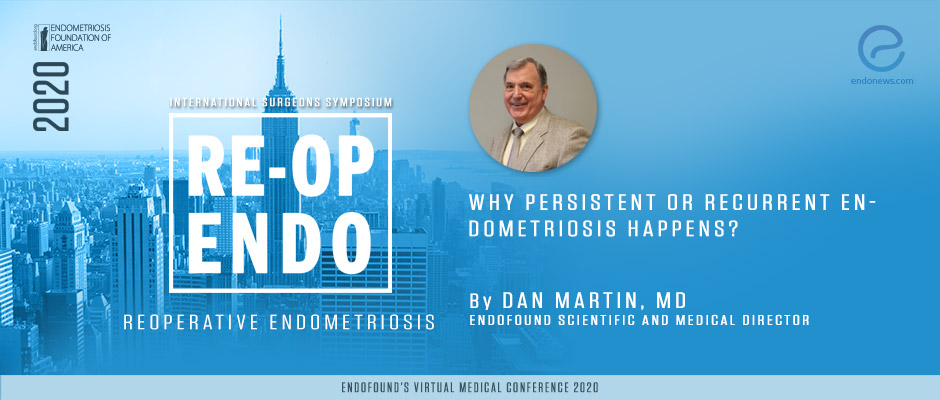Why Persistent or Recurrent Endometriosis Happens? - Dan Martin, MD
Jan 4, 2021
Paradigm shifts in Endometriosis
Key Points
Information about the presenter: Dr. Dan C. Martin is Professor Emeritus, University of Tennessee Health Science Center; a community member of the Virginia Commonwealth University Institutional Review Board; and a life fellow of the American College of Obstetricians and Gynecologists. He has been Divisional Director of Reproductive Endocrinology and Divisional Director of Minimally Invasive Surgery at the University of Tennessee and Divisional Director of Medical Education at The Johns Hopkins Medical Institutes. He was the Blossom Ball Honoree by the Endometriosis Foundation of America in 2013. Dr. Dan Martin’s presentation is entitled “Persistent Endometriosis, Recurrent endometriosis or other pain” in the Endofound Medical conference in 2020.
Highlights:
- It is not what "so far has been learned to find endometriosis clinically" but "how much is missed and undertreated endometriosis".
Importance:
- It is essential to understand the difficulties in the recognition of deep and hidden endometriosis, specifically how to identify small lesions and look alike lesions that can interfere in finding endometriosis.
Remarks:
- A paradigm shift in the structure of scientific revolution on endometriosis from less to more published endometriosis results, where PubMed published 28,766 articles on endometriosis, the rate of five articles published daily in 2020, and 10 times more of scholarly articles published in Google.
- Paradigm shifts in endometriosis on clinical techniques to treat endometrial lesions from 1980 to the present, particularly on excisions requiring laparotomy; diaphragm involvement and nerve dissection techniques are progressing from rare to routinely used to recognize and treat endometriosis.
- A shift in endometriosis models happens from visible to hidden specifically in bowels (from rare to 100% detection of > 2mm size lesion) and tubes (from 9% to 35% detected in the microscopic level).
- Endometriosis is missed and untreated because it may be deep and out of sight in the reproductive organ (ovary, retroperitoneal, bowels, intratubal); or difficult to see for technical reasons (tunnel vision (satellites), or due to the distortion in the course of dissection of deep infiltration, being microscopic - invisible by the naked eye (stem cells), and due to the inadequate technique to recognize and differentiate the micron size look-alike lesions.
Lay Summary
The objectives of Dr. Martin in this presentation are to understand the difficulties in recognition of deep and hidden endometriosis, difficulties in recognition of small lesions of micron size, and differentiate the look-alike lesions of endometriosis. He addressed overcoming these difficulties by presenting the progress in research and clinical techniques in the detection of endometriosis and the prevalent occurrence of small lesions that are hardly detectable.
In the 1970 and 1980s, diaphragm involvement was rare but now 3% of patients are anticipated to have diaphragm involvement which asymptomatic. Nerve involvement by endometriosis was also rare but at present, Dr. Marc Possover in Switzerland is teaching to perform nerve dissection in treating patients with nerve involvement.
Dr. Martin discusses the paradigm shift in endometriosis models in detecting from visible to hidden endometriotic lesions. Endometriotic lesions that are difficult to find are hidden mostly in the bowels and tubes. At present lesions in the bowels with size > 2mm is 100% detectable (Badescu et.al. 2016). The detection level of lesions in the tube increased from 9% to 35% at the microscopic level (McGuinness, Farr Nezhat, 2020). The shifts in endometriosis are continually happening.
Dr. Martin stated that what the community is learning, is not "to find endometriosis" but "how endometriosis is missed and undertreated". He informs us that endometriosis is missed because of the following reasons: It may be hidden inside the ovary, in the peritoneum, inside the tubes,... or other organs. It may be difficult to see it due to technical reasons (tunnel vision-satellites), as it may be microscopic (stem cells) where lesions are in micron size and it may be further distorted during dissection in deep infiltration. Endometriosis lesions may be difficult to treat because of inadequate technique (palpation, menstrual exams, and vaporization) or due to the location in unexpected sites. Furthermore, the differential diagnosis from look-alike lesions and its coexistence with fibroids and cancer are other problems.
Dr. Martin concluded his presentation by "Why pain after surgery is persistent or recurring", a difficult-to-answer question at the moment. He hopes that future paradigm shifts in endometriosis will give the community some answer.
Research Source: https://www.endofound.org/persistent-endometriosis-recurrent-endometriosis-or-other-pain-dan-martin-md?pop=mc
Paradigm Shift in endometriosis Diaphram involvement nerve involvement palpation peritoneal. imaging techniques vaporization mc2020

